INSIGHTS: Provisioning for a Long Offshore Passage
Provisioning for a long voyage is all about careful planning, storage space, dietary requirements and that extra “what if” scenario. Nicola Rodriguez, author and long-distance cruiser, shares her experience with tips and advice on how to best to stock up for a long offshore passage.
Published 4 years ago
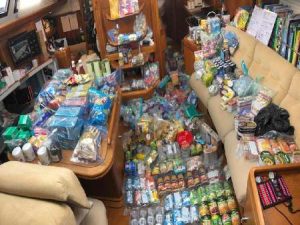

If you are usually at anchor, think about investing in a day or two in a marina with access to shore power. If you are pre-cooking numerous dishes to consume on passage you can use treats such as the microwave and slow cooker and have fans to cool you in the hot galley. Incidentally, if you have a slow-cooker, that’s another casserole cooking while you head for the shops. Being on the dock also makes washing fruit and vegetables and loading the boat so much easier.
It’s an idea to arrange a night ashore for a treat in the final days of hot, sticky stowing pre-departure. It will take the pressure off if the saloon is still full of un-stowed drinks, tins, packets and provisions. Perhaps the restaurant you passed on the way to market or filling up with gas?
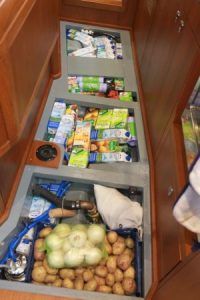

Before you start the lists of provisions, review the stowage capacity in your boat. It’s always tempting to buy extra of everything, just in case you can’t find that favorite produce where you are headed. However, having excess tins and dry goods with no where to stow them can be a problem if you don’t know exactly how much space you have.
Give yourself plenty of time to provision for a long voyage starting weeks beforehand when you happen to be in easy access of large supermarkets or easy provisioning. In addition to buying from supermarkets and transporting back to the boat, the stowing and re-stowing (and often more re-stowing), takes time. I am always surprised how our boats have opened up, with surprise nooks, but it takes time to find them.
Treasures of the Bilge
Do you want to keep bottles and tins in the bilge? You can fit a lot in but many cruisers prefer not to store items under the floorboards.
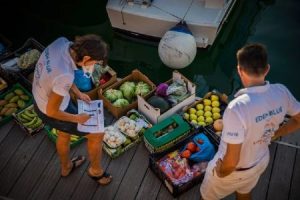

It is important to have a book or stowage chart to keep note of what is stowed where on board. Every cook has their own logic as to what goes where. Alphabetical? Colour? For example – provisions wanted early in the voyage forward and week two and three, ‘aft’?. Or, all the meat in tins on the port for red? Or, all the tins of tomatoes and kidney beans near the tins of mince for bolognese or chilli con carne? All the puddings, e.g. tinned fruit, rice pudding, in one locker? Or carbohydrates in one locker e.g. pasta, rice and flour? Whatever your version of a logical system, write it down in your book or on your chart.
Here is an example of the use of the notebook for knowing where and what you have stored – easily understood by everyone on board.
Supper Day 5 – Spaghetti Bolognese and pudding of peaches and custard.
Where is what?
- Onions and garlic. (Nets).
- Pasta. (Red dot in book/on chart with a 1 – port side locker 1).
- Tinned tomatoes, (Green dot in book/on chart with a 4 – Starboard. Locker 4).
- Tinned mince (Red dot with a 5 – Portside locker Locker 5) (Or freezer for prepared mince).
- Worcestershire sauce and herbs (Cuddy behind cooker).
- Cheddar cheese (Frozen, now in Fridge).
- Pudding. Custard and peaches (Green dot. Pudding locker ie Starboard Locker 5)
Record what has been used
As well as the location of stores within the boat, keep a careful record of what has been used. If you are sure of what you have used during the voyage, you can change the menu plan knowing you will not be short. Also, you will know what to re-provision when you arrive.
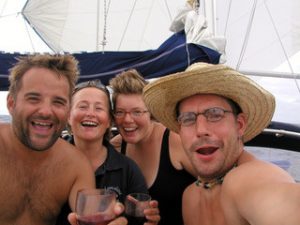

It is important to manage everyone’s expectations. Are they expecting tasty ‘comfort’ food or elaborate cuisine? During a pre-departure discussion, find out if your crew have any allergies? Nuts? Milk? Gluten? Coeliac disease?
- Are they vegetarian or vegan?
- What dishes and snacks do they prefer? Or not?
- Are they going to help with the cooking? Can they cook or do they think ‘cooking’ is using a can opener?
- Do you want your crew to help with cleaning the lockers (Bilge?), shopping and stowing – Or, not?
- How much do you want to do this yourself? With or without ‘suggestions’ from the crew?.
- Drop in the odd hint such as not using sea water to cook vegetables – it’s too salty.
In an article in Yachting World, How Do you Provision for a crew for three weeks or more at Sea, Julian Sincock (a charter skipper), says, “First, they work out a menu. I ask them to fill in a spreadsheet with a lunch and dinner idea and the quantities that will be needed for 12 crew and that generates totals on a master list. So, for example, we’ll know we need 48 onions and 13kg of minced beef frozen in 800g portions.”
For the majority of crews, meat forms the backbone of the provisioning list. This is fairly easy to estimate. Sincock says: “we work on 125g of meat per person per meal.” He has 12 on board so different appetites balance out, but smaller crews might prefer larger portions of 200-250g each.
If you are sharing the cooking explain to your crew that everything which is not used must be put back in its correct place. Also, they must clean up properly. Be sure your crew appreciate how you want your galley maintained.
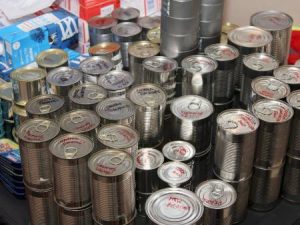

Breakfast and lunch are not usually cooked, but discuss this with your crew.
I kept breakfast a moveable feast lasting from 5am to 11am depending on night watch (cereal, or bacon rolls, eggs, pancakes or porridge).
Lunch can be left overs from the night before, or sandwiches, cheese and biscuits, perhaps pasta salad. Fruit and sweet biscuits.
Easy salads on board are those with mayonnaise. Think about variations of coleslaw/pasta/potato salad with or without beans and chives. In the first week of passage certain frutis and vegetables need to be used first (such as melons, avocados, lettuces, cucumbers and tomatoes). I predicted a large round of Manchego cheese would last 10 days, it barely made it past five.
Try to be flexible. By lunch time most of the crew are awake, but, if they came off watch at 6am, and, maybe have slept in, they will have just had ‘breakfast’.
By supper most people are rested and start focussing on “The Meal of the Day”, a hot supper.
On our boat, suppers and bread making became competitive and a great morale booster. Bread making was an afternoon activity. If an experimental loaf is a success or failure, it can give everyone ideas of what other bread they can make, as well as a few jokes. “It’s bread but not as you know it.” Beer bread caused many giggles.


Along with bread making and cooking, washing up was on a rota. If you are using a bucket for washing up, before throwing the dirty washing up water overboard, check the bottom where the knives and forks are found. Our boat dealt playing cards for who washed up, but, either way, those who cooked did not wash up.
Snacks
I kept a box with individual bags of snacks such as chocolate, crisps and nuts for night watch. I also asked the crew who were coming off watch to make a thermos of tea, coffee or hot chocolate for the next watch.
The blog of cruising family MotherShipAdrift echoes the woes of many sailing families, during even a short five-day trip. … “food becomes a big issue aboard as we try to eat a balanced diet and work out who stole the chocolate biscuits/ cookies. See how a small problem can become a big issue …….!”
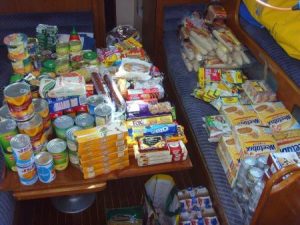

Most cruisers do not use a great deal of energy, so you are unlikely to require high calorie intake. Crews on racing boats will, of course, require more.
It is not a weekend jaunt but a long voyage, so the cooking is about being comfortable in your galley. Don’t try anything new, stick with cooking what you know (be it spaghetti bolognese, macaroni cheese, curry, chilli con carne, risotto/paella, shepherds/cottage pie).
While making your list, remember that there may be ingredients which are cheaper or more available in a supermarket and it may be worth stocking up with food for your long term cruising, not just the next passage.
If you are sailing for three weeks, provision for four.
Breaking it down – if you have a crew of 4 – you will require 28 breakfasts, lunches and dinners. There’s nothing wrong however with keeping it simple and making a weekly menu plan that just gets repeated every week. So 7 breakfasts, 7 lunches and 7 dinners.
If you decide on 10 pasta dinners, then buy 15 packets to be safe. The same with rice. Perhaps try noodles for some meals and potatoes last well in nets.
Look at your recipes for the quantities of ingredients for a dish. For example, Beef Casserole for five requires 850 grams of beef, one onion, two sticks of celery, two carrots, two cubes of beef stock plus bay leaves, tomato puree, Worcester sauce etc. Multiply this by the number of times you are going to make it and do the same for all the other dishes you plan to have in your menu plan.
Onions and garlic are the base of many meals, so for a 3 week voyage be sure to have at least 10 whole garlics, and 30 onions, unless you have prepared and frozen several ‘bases’ for meals in advance. How much leeway do you want to go off the menu plan?
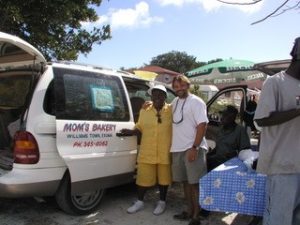

Allow yourself four or five provisioning trips. Start with the basics two weeks in advance, and work towards your departure date for the fresh food.
If you are on remote islands share a taxi with other cruisers so you can visit several shops to fully tick off all the items on your list. For those exploring remote islands particularly in the Pacific, be mindful that provisions may not be in plentiful supply and the locals, despite their generosity should come first.
If you feel panicked, tell yourself it is really not that different from a usual shop, just alot more!
The first shop is for:
- Strong flour for bread making
- Pasta
- Rice
- Tinned goods – meat, tomatoes, (vegetables?), baked beans, lentils, chick peas, black eyed/kidney beans, and for puddings – custard, rice pudding and fruit.
- Bottled water.
I allowed two tins a person for my big eaters and set sail with lockers filled with tins of beef/chicken casserole, mince, chicken in sauce, and chicken tikka. I bought Cassoulet in France and dozens of tins along the east coast of Spain, and Marks and Spencer in Gibraltar. A few were left for the Caribbean.
Closer to departure buy meat, cheese, hard vegetables and fruit (see notes on this further down).
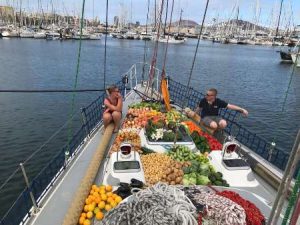

Water
It is essential to have more than enough clean drinking water on board.
Make sure your water tanks are clean. Some cruisers use water purifiers to be absolutely sure. Lemon juice is said to be an alternative to chlorine tablet purifiers. Remember when you are stowing to keep the boat equally balanced, for example, water and tins are heavy. I have seen a boat list to port when the water tanks were filled, that side of the boat was distinctly heavier.
If you are using bottled water, crush the bottles before putting them into the recycling.
Fruit
Choose oranges, apples, pears, limes and lemons, ‘hard’ fruit, not soft. (Freezing grapes and pomegranates give easy fruit later on in the voyage).
Dried fruit (my favourites mango and apricot), are good snacks. (Too many causes diarrhoea).
Remember that bananas release a ‘gas’ ‘which makes other fruit ripen faster by breaking down the cell walls. Keep them separate and bear in mind that all will probably ripen at once.
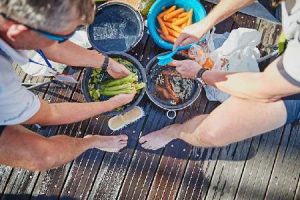

Potatoes, carrots, onions, garlic, radishes, (beetroots?), squashes and celeriac are all good choices for long passages. (Maybe peppers for the first week). If you have space, it is best not to store onions and garlic with the potatoes.
Wash and dry all fruit and vegetables. We don’t need the “stowaways” they can bring. I have known ultra-cautious cruisers use diluted bleach mixture. The fruits and vegetables should be thoroughly dry, as this stops them rotting.
Meat
A week or so before your estimated departure, arrange with the butcher to deep freeze your meat so it comes on board already frozen. The day before your estimated departure, collect your deep frozen meat.
Alternatively, buy vacuum packed meats (many butchers will do this for you) or do-it-yourself.
Eggs
It is lovely to have a fry up, but do you have the room to keep eggs safely?
In the last days of provisioning buy eggs. Many recommend turning them every few days to keep them, ‘fresh’, i.e. prevent the air sack sticking to the inner shell.
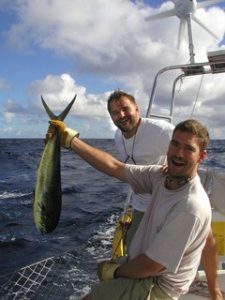

The radio check – position and weather – was an important part of the voyaging day. Once this was completed the essential discussions on what fish had been caught, at what speed with which lure. It is delicious to eat fresh fish on passage but do your research on the right kit and how to deal with the boat should you get a strike. Alan Shephard has some good tips on his blog.
Spice and all things that make dishes nice
Spices, dried herbs, condiments such as ketchup, HP sauce, mustard, soy, Worcestershire sauces, curry paste/ powder and tabasco enliven a meal. Pumpkin seeds are good to add to cabbage/carrots and onions for coleslaw. Fresh herbscan be stored in oil. Peanut butter is an easy go to ONCE you have double checked for nut allergies.
7. Equipment
With the constant movement bear in mind what equipment you require for cooking. “Sticky’ place mats keep utensils in place. Are your pressure cooker, favourite pans (for me, non-stick), and bowls easily accessible when heeling over?
Fiona Simms (The Boat Cook Book), in an interview with YBW.com, suggests, “Measure the top of your hob first and check that the pans will be able to sit together in most combinations”, along with many more great tips for cooking and provisioning on board.
If you are hit by a storm, do you have a locker which you can get to in all conditions which you can grab tins to make an instant meal to keep the crew going until the sea calms? You don’t want to be hunting through the back of lockers.
Sailing author Tom Cunliffe recommends that cooks wear “oilskin bottoms” to protect them from spills if it is rough.
Pressure Cooker
Think about what kind of food you want to cook in the expected conditions for your passage. Thick soups made up from tins and packets, or de-frosted casseroles? Try to aim for one pot cooking. Your pressure cooker is your friend. You can make all kinds of dishes and save on gas.
If you want to know more about using Pressure Cookers, read Heather Francis in Blue Water Sailing: Galley Guide on Pressure Cookers.
Cooking Gas
Do you have enough gas? What gas-saving techniques can you adopt (such as steam-cooking rice and pasta, solar ovens etc.) Is your gas cooker in good, safe working order? It is worth paying a professional to check the gas connections.
Fridge
How good is your fridge in hot climates? It may stay cool in northern climes, but can it cope as the temperatures rise? Does it need extra insulation?
Bowls
We like bowls with rounded edges which kept our meals safer (such as plastic dog bowls). Food tends to slide off flat plates when on passage. Equally, use mugs with lids.
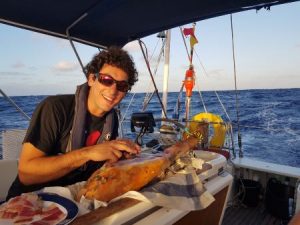

Frozen
As most cruisers know the golden rule is ‘KISS’ (Keep It Simple Stupid). Freezers are a treat (some would say essential), but be prepared if they fail. The generator on a new boat, (on our crossing), failed half way across the Atlantic. The cook had meticulously prepared meals, labelled and frozen them in advance. They began to melt and had to be thrown overboard. This not an isolated story.
Depending on how much you trust your freezer, you can prepare 30 dishes, one for each supper. Some cooks do half and half (freeze 10 mince bases, which when they are defrosted have extra ingredients added, to become chilli con carne, or bolognese or lasagna). Or, five frozen chicken curries which when de-frosted have fruit or nuts or vegetables added?
If all you have is a fridge, deepfreezing your meat, preferably by a friendly butcher, will give you at least a week in a fridge and bring down the temperature of the fridge.
A tip from campers is to freeze large containers of water (which can still fit into your fridge). This takes up space, but gives an extra three days of chill and water as they melt.
It is advisable not to freeze fruit and vegetables with a high-water content such as cucumber, lettuce, melon, celery and bean shoots. ‘Cream based products’ such as sour cream or cream, and egg based sauces such as mayonnaise, separate when defrosted. (You can use cream cheese as an ingredient.) Fried food becomes soggy, when thawed. There are varying opinions on yoghurt, rice and pasta.
Top Ten tips on Freezing Food, plus how to freeze eggs, yoghurt, milk and cheese by BBC Good Food, plus A Guide to What you Can’t Put in the Freezer by the Independent are useful articles.
Vacuum Sealing
Many long-distance cruisers swear by vacuum sealed food. It can last 1 -2 weeks in a fridge. Vacuum packing sucks out the oxygen extending the shelf by limiting the growth of aerobic bacteria and fungi. Fans claim it seals in the flavour and juices. (Detractors say vacuum sealing encourages a different type of bacteria.) You can do it yourself or buy it in supermarkets.


Lightweight and high-energy, these are simple to prepare (just add hot water) and good to have on board for rough weather and quick night-time snacks for hungry crew.
In an article in Square Meal’s “Let’s Do Lunch”, Dame Ellen MacArthur tells the story of how the dehydrated packets got wet and the labels came off her dry foods, “I was expecting beef bourguignon and I got fruit trifle. On the record attempt, we made sure that the food was labelled a bit better.”
Dried milk is a good back up to UHT milk and saves space.
Canning
I have known cruisers use this method even within the confines of a small galley. The process seals food e.g. fruit, vegetables, sauerkraut, pickled cabbage, jams, in mason jars, (e.g. Kilner with pressure sealed lid) preserving it for at least a year. https://foodinjars.com is a useful resource.
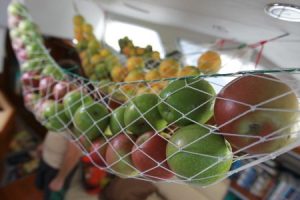

Nets are great for storing fruit and vegetables as they keep them fresher, longer and use up space which is not usually used. Some cruisers secure smaller nets at the back of lockers to hold small bottles.
Rolling over 30 degrees to port and way over again to starboard, all day, every day for 20 days, this was our Atlantic Crossing. While tied to the dock or in a protected anchorage, it is difficult to imagine the nets full of fruit and vegetables, swinging wildly, but they do! So pack them carefully and check daily for ripe or bruised ones that need using first.
Boxes
Flour is best kept in plastic boxes to prevent weevils. I suggest dividing the flour into several boxes to ensure as many ‘fresh’ ones as possible. The smell of bay leaves is unattractive to weevils, cockroaches, silver fish and mice so sprinkle a few in your flour containers and around your lockers. I know sailing cooks who freeze their flour for a week to kill weevil eggs.
Plastic Bags and Silver Foil
Bags of crisps and tacos will take up less space if put in a plastic storage bag. When planning your “South American” night you can store several bags of tacos in one plastic bag (zip lock) which can be marked, “For taco dinner only”. Equally naan bread for “Asian night”.
Left overs from supper, such as pasta, can be ziplocked and stored in the fridge. For lunch the next day, you can add mayonnaise, peppers, tuna etc. for a quick and easy salad.
Individual snack bags for night watch can stop over-enthusiastic snackers.
Cling film and silver foil keep sandwiches fresh. As with ziplock bags leftovers can be kept in the fridge in silver foil which has been labelled and cling film.
Glass
I have known cruisers who do not like to have glass containers on boards. Others use socks or bubble wrap or tea towels to keep bottles of wine safe. I try to buy marmite, peanut butter and jams in plastic containers.
The Boat Galley Cookbook recommends a PVC pipe, cutting the length to match each bottle – wine, oil, etc. They also suggest storing nuts, tea and coffee in the spaces between the necks. Read their tips on glass on board.
See this very useful article by Cruising World detailing lists of vegetables and fruit, their expected shelf life and stowage requirements on board, plus products with long shelf lives and how to best store them – Cruising without a Fridge.
9. Rubbish
Rubbish is kept in strong bin bags which are secured firmly onto the bow. As at home/marinas, one bag for recycling and one for ‘general rubbish’. Fold or crush plastic, tins and cardboard. Minimise rubbish on board by taking on as little plastic and packaging as possible when you are loading. Theoceanpreneur.com dictates, “Your waste might sink into the deep but it won’t be gone. No glass, no cans, no paper, no cardboard can go overboard.”
Stowaways
Removing cardboard and packaging saves space. It is also worth the effort as critters can lay their eggs in cardboard.


“Parties” during a long voyage gives everyone something to look forward to. It will raise a smile if the passage is difficult. On one of our short passage, in the five days between Gibraltar to Tenerife, it was Halloween so we had a Party. There are all sorts of hooks to hang celebrations upon, e.g. the first week, half way, Birthdays, Anniversaries, full moon, first 1000 miles. If you are going to have themed parties – with food, costumes or games – it advisable to have a large supermarket within range. Even better have a crew member who is flying in bring goodies from shops which have not been raided by party-minded crews.
We ran a ‘dry’ boat, with the exception of one glass of red wine at the half way point. Clarify with the crew so they know what to expect. Ditto smoking.
11. Step by Step
Take it step by step, list by list and chart by chart. Always give yourself time before you set off to discuss dishes with the crew, shop, load and stow, shop, load and stow.


Closer to departure buy meat, cheese, hard vegetables and fruit which will last, especially if kept in nets. I bought my fruit, veg and cheese in a local market. Fruit and vegetables from a supermarket are more likely to have been refrigerated and will require refrigeration on the boat as they will ripen faster if un-refrigerated.
13. Customs Regulations
Always be informed of customs regulations in countries you plan to visit. When we arrived in Cuba I had carefully researched all the regulations on not bringing in meat and fruit. What I had not anticipated? One of the many customs authorities ended up with our 12 pack of Diet Coke in his capacious brief case!
14. Draw on the Experience of Others
When faced with a long passage or difficult conditions advice from experienced sailors has guided me over many thousands of miles. Below this article you will find numerous suggestions for future reading and viewing.
……………………………………………………………………………………………………………………………………….
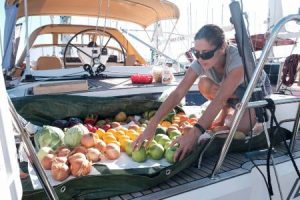

The following are blogs/websites. articles and books I have found useful and interesting over the years:
Blogs/websites:
www.theboatgalley.com
A good read through this website will be time well spent. You could subscribe to their newsletter. It is full of good advice, recipes and tips including Five Tips for Bread Making, How to Store Meat on a Boat and Glass Storage.
https://yachtkate.com/tag/galley-notes/
An eclectic and entertaining read by sailing writer/chef Heather Francis, from pickling pineapple, how to be green in your galley to stove-top bread baking.
https://sailingbritican.com
Sailing lifestyle coaches on Sailing Britican give a “20 Top Tips for Provisioning for a Long Sailing Trip”.
https://www.sailingtotem.com
Behan Gifford, circumnavigator, liveaboard and writer with a family, gives all kinds of good advice in her blog including long-term provisioning.
Articles:
Food For Thought Provisioning and Cooking Underway by Heather Francis for Blue Water Sailing.
I smiled reading Jason K Stern’s 2002 quirky article on “World Provisioning” for Cruising World.
Books:
“Care and Feeding of your Navigating Crew” by the Pardeys.
Whatever the question on provisioning, menus or food on board, I found a good answer. This is my current “go to” reference book.
“Storing Food Without Refrigeration” by the Boat Galley.
The Beaufort Scale Cookbook by June Raper.
This is particularly useful on long voyages, it provides 100 recipes, each indexed by wind strength so you can cook something tasty in a storm, or more elaborate in calmer conditions.
The Trade Wind Foodie: Good Food, Cooking and Sailing Around the World by Rod and Lu Heikel.
Another experienced sailing couple who incorporate tales of their voyages with guidance on provisioning, cooking on board and recipes.
The Boat Cookbook: Real Food for Hungry Sailors by Fiona Sims.
A very popular book which shows how to set up your galley as well as providing a wide variety of recipes and sea trivia, plus, contributors from sailing legends (e.g. Mike Golding), and top chefs (e.g. Angela Hartnett).
The Boat Galley Cookbook by Carolyn Shearlock and Jan Irons.
Further reading and viewing:
After a hard day of shopping and storing you may want to see how the other half live, on Youtube. In amongst the scores of amateurs showing you how to cook on board there are superyacht chefs showing you how they do it e.g. James Wright in “Cooking for Millionaires on a Luxury Yacht”. “Food Delivery for a Superyacht” puts provisioning in perspective.
“The Hungry Sailors” presented by father and son team Dick and James Strawbridge, covers 50 episodes for ITV, (2011-13) exploring UK coastal waters including how to cook on board, or find interesting places ashore. It’s charming.
…………………………………………………………………………………………………………………………………..

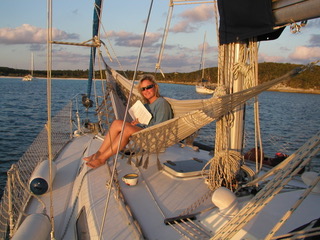
- Nicola writing an article for Yachting Monthly in Honeymoon Bay, George Town, Exhuma.
About the Author
John and Nicola Rodriguez sailed 25,000 miles from the UK to the Med to the Caribbean and USA, twice, over eight years. During their sailing adventure, two young crew members, their sons Jack and James joined the ‘crew’. They are now based primarily in the Solent on the south coast of the United Kingdom.
Nicola is the writer of “Sail Away, How to Escape the Rat Race”, a book which had guided and inspired many to sail away. The second edition was published by Fernhurst Books in January 2019. It has been described by Yachting Monthly as ‘A must for all aspiring ocean adventurers’.
John is a specialist yacht broker for blue water and high-quality cruising yachts.
John and Nicola are members of the OCC and RCC.
Read their cruising blog at http://theyachtseraphim.blogspot.com/
…………………………………………………………………………………………………………………………………..
Related Articles and Links:
- Noonsite’s Cruising Information page (with planning and preparation section)
- INSIGHTS: Sailing Away – Top 10 Tips (by Nicola Rodriguez) – January 2020
- Other INSIGHTS
…………………………………………………………………………………………………………………………………..
The opinions expressed in this article are the author’s own and do not reflect the view of Noonsite.com or World Cruising Club.
Related to the following Cruising Resources: Cruising Information, Insights, Liveaboard Tips, Planning and Preparation, Routing




Brilliant article – many thanks!
Please how do you read the articles. All I’m finding is intr page to article?
Just click on the next blue bar below that section that says “Report or News Content”. That will open the main body of the article.